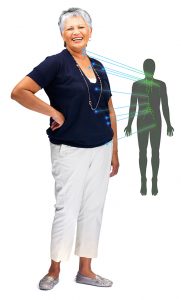Journey through Health: Immune System
Age-Related Immune System Changes
The immune system involves a network of tissues and organs scattered throughout the body. Tissues and organs involved in the immune system include the thymus gland, bone marrow, spleen, tonsils, adenoids, lymph nodes, lymphoid tissue, and lymphatic vessels.
The immune system defends the body against infections from bacteria and viruses.  The immune system also helps protect against inflammatory conditions such as arthritis.
In addition, the immune system protects against other health problems such as chronic
diseases and cancer.
The immune system also helps protect against inflammatory conditions such as arthritis.
In addition, the immune system protects against other health problems such as chronic
diseases and cancer.
Immune function tends to decline with age. As a result, risk of infections, inflammatory conditions, and cancer tends to increase with age. In addition, antibiotics used to treat infections are not as effective if the immune system is compromised. Furthermore, a compromised immune system can reduce the body’s ability to respond to influenza and pneumonia vaccinations.
Diet, Physical Activity, Food Safety, and Immune System Health
A healthful diet and regular physical activity are essential for maintaining a healthy immune system. Because immune function tends to decline with age, it is also important to follow safe food handling practices.
Diet.
A healthful diet has an important role in maintaining the immune system. Many nutrient deficiencies can compromise immune function including calories, protein, vitamin A, vitamin E, vitamin C, zinc, copper, selenium, magnesium, and iron.
The role of many nutrients in immune function highlights the importance of a healthful
diet including fruits, vegetables, low-fat dairy, whole grains, and lean protein foods.
Consuming a variety of nutrient-rich foods can provide the body with the nutrition
it needs every day. The Dietary Guidelines provide guidance for a healthful diet.
Physical Activity.
Physical Activity. Physical activity is also beneficial for immune function. Regular physical activity can help to maintain immune function. Physical activity recommendations are at least 150 to 300 minutes of moderate-intensity physical activity a week, or 75 to 150 minutes of vigorous-intensity physical activity, or an equivalent combination of moderate and vigorous-intensity physical activity.
Food Safety.
The immune system helps the body defend itself against foodborne pathogens. However, the immune system tends to decline with age. This is one reason why the risk of foodborne illness increases with age.
Following safe food handling practices can lower the risk of foodborne illness. Many
foodborne illnesses are caused by unsafe food handling practices in the home. Some
food handling practices that can lower the risk of food safety problems in the home
are washing hands, thoroughly rinsing vegetables and fruits, preventing cross-contamination,
cooking foods to safe internal temperatures, and storing foods safely. These practices
are highlighted by the four basic food safety principles which work together to reduce
the risk of foodborne illness. These principles are:
- Clean. Clean hands, food contact surfaces, and vegetables and fruits.
- Separate. Separate raw, cooked, and ready-to-eat foods while shopping, storing, and preparing foods.
- Cook. Cook foods to a safe temperature.
- Chill. Refrigerate perishable foods promptly.
MyPlate Messages Promoting Immune System Health
Several of the MyPlate messages can help promote immune system health.
Build a Healthy Plate
- Make half your plate fruits and vegetables.
- Switch to skim or 1% milk.
- Make at least half your grains whole.
- Vary your protein choices.
- Keep your food safe to eat.
- Follow the four food safety principles: clean, separate, cook, and chill.
Be Physically Active Your Way
- At least 150 to 300 minutes of moderate-intensity physical activity a week, or 75
to 150 minutes of vigorous-intensity physical activity, or an equivalent combination
of moderate and vigorous-intensity physical activity.
- If you cannot meet this guideline, be as physical active as your abilities and conditions will allow.
- Include muscle-strengthening activities that involve all major muscle groups on two or more days a week.
Sources
Bernstein M, Luggen A.S. Nutrition for the Older Adult. Sudbury, MA: Jones and Bartlett publishers; 2010.
Crews JE, Campbell VA. Vision impairment and hearing loss among community-dwelling older Americans: Implications for health and functioning. Am J Public Health. 2004;94:823-829.
Coleman H, Chew E. Nutritional supplementation in age-related macular degeneration. Curr Opin Ophthalmol. 2007;18:220-223.
Fletcher AE. Free radicals, antioxidants and eye diseases: Evidence from epidemiological studies on cataract and age-related macular degeneration. Ophthalmic Res. 2010;44:191-198.
Lein EL, Hammon BR. Nutritional influences on visual development and function. Prog Retin Eye Res. 2011;30:188-203.
National Institute on Aging. AgePage: Aging and your Eyes. 2009.
United States Department of Agriculture. Dietary Guidelines for Americans 2020-2025.
United States Department of Agriculture. ChooseMyPlate.gov. Accessed at www.choosemyplate.gov
United States Department of Health and Human Services. 2018. Physical Activity Guidelines For Americans. 2nd ed.
